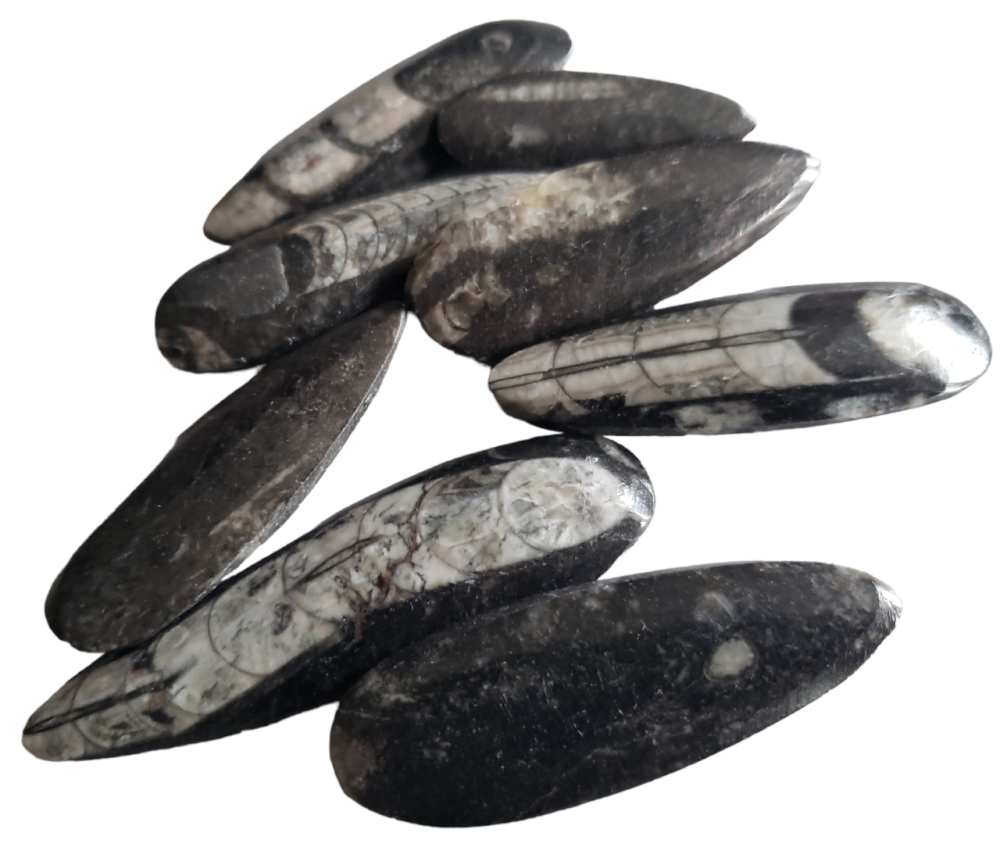We use cookies to make your experience better.
TimmersGems has a new website, existing customers also need to register again.
Sharpened Orthoceras our best-selling fossil!
100% eerlijk fossiel, waarbij de “pijlstaartvisjes” er geaccentueerd uit komen in het moedergesteente.
Availability:
In stock
SKU
120076
- Buy 25 for €0.99 each and save 50%
- Buy 100 for €0.88 each and save 56%
- Buy 500 for €0.78 each and save 61%
Orthoceras is an extinct genus of molluscs that lived during the Middle Ordovician. This nautiloid cephalopod had a tapered, cylindrical, cone-shaped shell with closely spaced chambers containing a concave and a convex septum, with a connecting tube called the sipho in the center. The length of the shell was about 15 cm. Orthoceras was a good swimmer, feeding on carrion and small animals. The shell always remained in a horizontal position while swimming. Fossils are all remains and traces of plants and animals that are preserved in rock. Although it is often thought that fossils do not have to be 'petrified'. Very many fossils are indeed not petrified. Fossil remains are known even from very old rocks that have hardly changed. Furthermore, many think that fossils are always very old. This is also incorrect. Many very young fossils are known, originated in periods known to humans. The science that studies fossils is called paleontology. This area of knowledge aids in the study of rock sequence, a branch of geology called biostratigraphy. Because remains of life only fossilize under specific conditions, fossil information is limited and by definition "incomplete". The word fossil often brings to mind the bones of dinosaurs or mammoths and it is true that the hard parts of an organism have the greatest chance of being preserved by fossilization. For vertebrates, these are the bones and especially the teeth. The softer tissues of the organism are preserved only in special cases and are therefore much rarer. Softer tissues are only preserved if they are quickly buried under a layer that protects them against any form of rotting or damage. With only the hard parts it is sometimes difficult to form a good picture of the complete organism. A good example of this are the Conodonta, which were found in large numbers for a long time, but were known only from their teeth. It was only when an imprint of the rest of such an animal was also found that it turned out to be a primitive form of the Chordata tribe. Other hard parts, such as shells, are often fossilized in other animal groups. There are a number of special forms of fossilization. For example, complete insects are sometimes found enclosed in amber, because the resin from which the amber is formed forms a good barrier against oxidation. This also applies to tar pits on a larger scale. Near the American city of Los Angeles, a good example of this is in the La Brea tar pits. The bones of animals that became trapped in the tar pit were often very well preserved. In addition, the trapped animals often attracted predators, who also became entangled. A "bone graveyard" was formed in this way during the Pleistocene. Very well preserved fossils are often found in clays deposited in stagnant anoxic water. Due to the absence of oxygen, plants fossilize particularly well in it. Very often not the entire water column is deoxygenated, but only the lower part. Such stratified water therefore has a normal oxygen content in the upper layer. Organisms die in the upper layer, which then sink down and end up in an oxygen-free environment where they are preserved. Living organisms can also unintentionally end up in the lowest anoxic layer, causing them to die and fossilize. In such a deposit, fish are sometimes kept in a cramped manner indicating suffocation. A well-known rock with such fossils is the 'Kupferschiefer' from the Rotliegend in central Germany. In addition to remains that originate from organisms themselves, traces that have been made active or passive by organisms are also considered fossils. This includes, for example, coprolites (fossilized excrement) and trace fossils such as paw prints and burrows. It is not always possible to determine from trace fossils which animal they come from.
| Dimensions | 5060mm |
|---|---|
| Country of Manufacture | Morocco |












